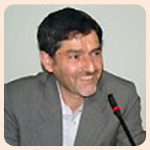Presidents Letters

The Department of Nuclear Medicine looks forward to a productive meeting and aims to provide an enriching environment for sharing and exchanging new ideas in all fields of nuclear medicine.
We hope to bring together prominent scientists in the field of nuclear medicine from all around the country and the world in the beautiful and historical city of Shiraz to benefit from inspiring and state of the art presentations and enlightening panel discussions. We look forward to welcoming you to the 2013 ICNM and sharing the latest scientific achievements in the field of nuclear medicine during a memorable stay in the beautiful city of Shiraz.
| Mohammad Hadi Imanie, MD
Congress President & Shiraz University of Medical Sciences President |
 |

The modern Shiraz University, established after World War II, was quick to engage in Nuclear Medicine as a subsidiary of the division of endocrinology in the Department of Internal Medicine. Dr. Barekat as the head of the unit, performed radioiodine investigation of the thyroid already in the late 50s barely one decade after its world inception. Similar and concurrent endeavors proceeded in Tehran by Dr Nezam-Mafi who was also an endocrinologist and a pioneer of Nuclear Medicine at the University of Tehran. The unsuccessful military Pact of CENTO, initially designed to serve as the eastern wing of NATO, provided many high-tech facilities to the newly constructed Nemazi Hospital which was run by a predominantly American staff. With increasing sophistication of Nuclear Medicine and introduction of radionuclide anatomic imaging in addition to metabolic studies, the section of nuclear medicine was incorporated to the Department of Radiology to acquire a new independent status in 2011.
Introduction of computerized tomographic imaging by Kuhl and Edwards in nuclear medicine and later development in radiology by Hounsefield and Cormack in 50s, is witness to the ingenious contribution of the great Persian scientist Al Khawarazmi who described the method of determination of an unknown element by construction of algebraic equation. The basic idea, thus is to create sufficient number of equations which would render a set of simultaneous and linearly independent system to feed the computer for calculation of the enormous data obtained from varying acqusition angles.
While wishing our participants an enjoyable visit to this historic city of Iran, we strive to make the upcoming meeting as informative as possible for colleagues interested in nuclear medicine and allied sciences.
| Karim Vessal, MD
Congress Chairman and Fellow, Iranian Academy of Medical Sciences |

